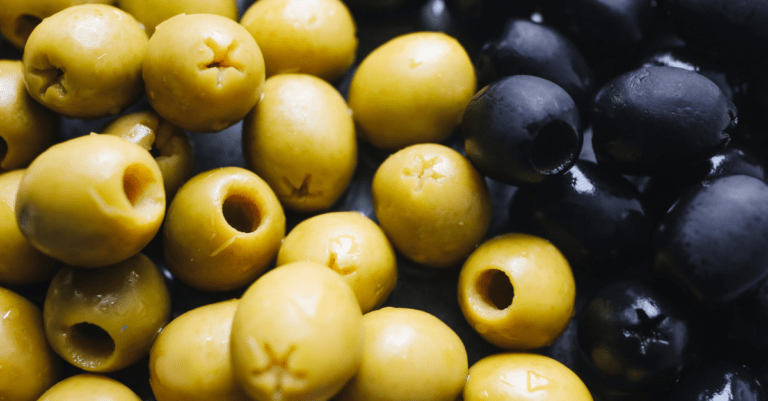When I was growing up, there were only two kinds of olives at the grocery store: green olives stuffed with pimentos and pitted black or “ripe” olives that you could wear on the tips of your fingers until your Mom made you stop playing with your food.
Today, of course, most grocery stores have entire olive bars, with all kinds of exotic varietals—everything from the tiny brown Nicoise to the giant, bright-green Cerignola, to the shriveled black Morrocans.
But “are they all the same nutritionally?” asks Grace. “Or are some types particularly good for you?” Meanwhile, Tania wonders how olives compare to olive oil in terms of health benefits.
Do Olives and Olive Oil Have the Same Benefits?
Both olives and olive oil are promoted as healthy foods primarily because they are high in monounsaturated fats. Cultures whose diets are rich in this type of fat tend to have lower rates of heart disease, cancer, and obesity—even when their total fat consumption is on the high side. In fact, some researchers theorize that monounsaturated fats might be slightly less “fattening” than other types of fat because the body metabolizes and stores them differently. Monounsaturated fats also seem to be less likely to contribute to clogged arteries and heart disease.
The Differences Between Olives and Olive Oil
Here’s one big difference between olives and olive oil: Oil is virtually 100% fat, while whole olives are only about 20% fat. As a result, a serving of olive oil (1 tablespoon) contains 120 calories while a serving of olives (about 10 medium) has only 40.
There are a few other distinctions:
- Olives, which have to be cured or pickled in order to be edible, usually contain a lot of sodium while olive oil is virtually sodium free.
- The curing process removes a lot of the polyphenols in olives whereas these are largely preserved in extra virgin olive oil. (Polyphenols are phytonutrients thought to protect against disease.)
- Whole olives provide some fiber; olive oil does not.
- Some olives are processed with natural fermentation, meaning that they would be a source of beneficial bacteria; olive oil is not.
As you can see, olives and olive oil each have pros and cons. But it’s a little silly to try to compare them because they’re really not interchangeable. You’re not going to sauté your spinach in a handful of olives and you’re probably not going to have a tablespoon of olive oil as a snack. Suffice it to say that olive oil is one of the healthiest oils you can choose and olives make nutritious snacks and condiments.
What’s the Healthiest Type of Olive?
Green olives, which are picked before they ripen, tend to be higher in polyphenols. Black olives, which are allowed to ripen on the tree, generally have higher oil content.
Green olives, which are picked before they ripen, tend to be higher in polyphenols. Black olives, which are allowed to ripen on the tree, generally have higher oil content.
I’ve written previously about the best types of olive oil to buy. But what are your best choices when you belly up to the olive bar?
The concentration of oil and polyphenols varies according to the variety of olive and the degree of ripeness. Green olives, which are picked before they ripen, tend to be higher in polyphenols. Black olives, which are allowed to ripen on the tree, generally have higher oil content. Both ripe and unripe olives are good sources of iron, copper, and vitamin E.
How are Olives Processed?
As I said earlier, you can’t eat olives straight off the tree—even if they are “ripe.” Raw olives are hard and bitter. To make them edible, they are pickled in brine, or cured in salt or oil. The curing process removes bitter compounds (some of which are those healthy polyphenols), softens the fruit, and imbues them with flavor. It also imbues them with a fair amount of sodium.
Which Olives Have the Least Salt?
The amount of sodium in processed olives depends on their curing process. Unfortunately, detailed nutrition information may be hard to come by at the olive bar. In my experience, the big Cerignola olives are among the least salty varieties. And as a general rule, black olives will have about half the sodium of green olives.
If you’re very salt sensitive, you might want to skip the bulk olives and stick with olives in jars, which have nutrition facts labels. Here, too, your options have increased. In addition to the classic green-with-pimiento, even a modestly-stocked grocery store is likely to carry kalamata, Seville, and maybe even some oil-cured olives in jars..
Olives and Acrylamide
One last tip: As much fun as they are to wear on your fingers, some canned black olives have been found to be quite high in acrylamide. Since acrylamide has not been detected in other kinds of olives, it probably has to do with the way canned black olives are processed.
I talked about the potential dangers of acrylamide in a previous article. While I personally don’t think you need to worry that much about acrylamide exposure (especially when there are so many other things to worry about), that information might change how often you choose to indulge in canned black olives. If you like that style of olive (slightly sweet and fleshy), try ripe Cerignola instead. They’re even tastier.
What’s your favorite way to enjoy olives? Share it below in Comments or post it on my Nutrition Diva Facebook Page. And don’t forget to sign up for my free weekly newsletter, which includes more tips, recipes, and answers to listener questions.
Have a great week and remember to eat something good for me!
RESOURCES:
Are Monounsaturated Fats Less Fattening? Nature Journal
Straight Dope on Green and Black Olives
Varieties of Olives (with pictures) Cook’s Thesaurus
Oil and Polyphenol Content by Olive Variety
Olives image courtesy of Shutterstock




